| |||||||
| Search Forums |
| Advanced Search |
| Go to Page... |
 |
| Search this Thread |  692,268 views |
| | #1036 | |
| Distinguished - BHPian  | re: Scale Models - Aircraft, Battle Tanks & Ships Quote:
https://www.businessinsider.com/full...true&r=US&IR=T But yes, the F16s will be phased out as we receive more F35s. Somehow I do not believe the Dutch government will put them up for private sale at Ebay. Loverly aircraft and of course for me some Dutch pride. I have flown many, many times with F27s all over the world. It was also the only aircraft in which I found myself in quite a serious incident many years ago in Gabon. Passengers and crew survived! During my teens/college years I was a member of a aviation enthusiast club. We had at least one or two visits per year to the various Fokker plants across the Netherlands. The Dutch airforce used to fly them as well in the so called troopship configuration. At airshows they used to do an awesome demonstration. In an interview the then demo-pilot was asked how he managed to to fly this low. His answer was legendary and not appreciated by his superiors. “You keep lowering it, until your altitude reading is zero, than you drop it some more till you havo no altitude reading, which means you have just snapped of the antenna!” Since then he had to pull up a few more feet as you see in this video. Even what is shown in this video is low, even in those days! Of course, we do not see such demo flying anymore Jeroen Last edited by Jeroen : 26th October 2019 at 12:10. | |
| |  ()
Thanks ()
Thanks
 |
| |
| | #1037 | |
| Senior - BHPian | re: Scale Models - Aircraft, Battle Tanks & Ships 1:72 Sukhoi Su-25 "Frogfoot" Red 59, 378th OShAP, Soviet Air Force, attached to air forces of the 40th Army, Bagram AB, Afghanistan 1986 ( Hobby Master) The Sukhoi Su-25 Grach (Rook); NATO reporting name: Frogfoot) is a single-seat, twin-engine jet aircraft developed in the Soviet Union by Sukhoi. It was designed to provide close air support for the Soviet Ground Forces. The first prototype made its maiden flight on 22 February 1975. After testing, the aircraft went into series production in 1978 at Tbilisi in the Georgian Soviet Socialist Republic. The type has seen combat in several conflicts during its more than 30 years in service. It was heavily involved in the Soviet–Afghan War, flying counter-insurgency missions against the Mujahideen. The Iraqi Air Force employed Su-25s against Iran during the 1980–88 Iran–Iraq War. Most were later destroyed or flown to Iran in the 1991 Persian Gulf War. The Georgian Air Force used Su-25s during the Abkhazia War from 1992 to 1993. The Macedonian Air Force used Su-25s against Albanian insurgents in the 2001 Macedonia conflict and, in 2008, Georgia and Russia both used Su-25s in the Russo-Georgian War. African states, including the Ivory Coast, Chad, and Sudan have used the Su-25 in local insurgencies and civil wars. Recently the Su-25 has seen service in the Russian intervention in the Syrian Civil War. In 1984, a brand new attack aircraft unit was purposely established for operation in Afghanistan : the 378th OshAP( Independent Attack Aviation Regiment), stationed at Bagram, Afghanistan. Initially, it was a two squadron attack regiment with a complement of 28 Su-25s: 12 in each squadron plus 4 Su-25s assigned to the regiment's command flight. The 1st AE (Aviatsionnaya Eskadrilya - Aviation Squadron) was stationed at Bagram and the 2nd AE at Kandahar. The pilots & technicians were drawn from the two existing Soviet Air Force front-line regiments at that time- the 80th & 90th OShAPs. The high intensity of the combat operations performed over the entire territory of Afghanistan resulted in almost 11,000 combat sorties being amassed in one year by the two squadrons of the 378th OShAP, between October 1984 and October 1985. Most of the CAS sorties were performed from altitudes of 1,960 to 3,280ft (600 to 1,000m) above terrain, thanks to the aircraft, decent armour protection, providing reliable resistance to the small-arms fire from the ground. Dropping bombs and firing rockets from such low altitudes resulted in accurate hits, making the Su-25 a deadly CAS asset. There were 12 occasions when the 378th OShaP's Frogfoots returned to the base on one engine as a result of combat damage of varying degrees that had forced the pilots to switch off the other engine. During its first personnel rotation, the 378th OShAP reported two aircraft and their pilots lost in action; in addition, it suffered from two more non-combat-related losses. The average number of sorties per aircraft in this period was 216, while the maximum number reached 315. The third rotation of personnel took place between October 1986 and October 1987. Between November 1986 and February 1987, four Su-25s were lost due to Stinger Missiles used by the Mujahideen. Su-25 defenses were upgraded as well as new tactics were developed. On 16 January 1984, a Su-25 piloted by a Russian Lieutenant Colonel was struck by a SA-7 missile and downed near Urgun, Afghanistan, making it the first shootdown of a Su-25 in the war. On August 8 1988, Col Alexander Rutskoy, commander of the regiment—was leading a night raid on the Maranshah refugee camp when his four-ship flight was bounced by two F-16As of the 14th fighter squadron PAF. Rutskoy turned hard towards the F-16s, perhaps seeking to draw them away, and believing the heat-seeking missile would lose its track if his plane’s hot tail-pipe was facing away from it. But the all aspect AIM-9L was designed to engage targets from all quarters, and the detonations of its proximity warhead broke the “flying tank” in two. Rutskoy ejected over Pakistani soil and was captured. Exchanged back to Russia, he was decorated as a hero of the Soviet Union and went onto become vice president of Russia under Boris Yeltsin. In October of that year, a Su-25 sustained a powerful hit at high-altitude north of Gardez, heavily damaging it but remaining flyable. The strike was reportedly the result of a missile fired by a Pakistani fighter jet. In January 1989, a missile hit a Su-25 near Kabul killing the pilot in the last combat loss of the aircraft in Afghanistan. Over the course of the Soviet–Afghan War, Su-25s launched a total of 139 guided missiles of all types against Mujahideen positions. On average, each aircraft performed 360 sorties a year, a total considerably higher than that of any other combat aircraft in Afghanistan. By the end of the war, nearly 50 Su-25s were deployed at Afghan airbases, carrying out a total of 60,000 sorties. Between the first deployment in 1981 and the end of the war in 1989, 21–23 aircraft were lost in combat operations, with up to nine destroyed on the ground while parked. More than a thousand Su-25s have been built since 1978 along with several variants. Modern Su-25s have an impressive array of countermeasures included a missile approach warning system, chaff and flare launchers, and an infrared jammer to confuse enemy missiles. Because the plane can both deliver and take a punch, countries like Iraq, Iran, Sudan, Ethiopia, and many former Soviet states also use Frogfoots. General Sukhoi Su-25 Specifications Manufacturer – Sukhoi Design Bureau Role – Close Air Support (CAS) Number Built – 1,024 User Countries – Approximately 28 Crew – 1 (Pilot) Dimensions Length – 15.53 m (51 ft) including nose probe Wingspan – 33.7 m (47 ft 2 in) Height – 4.8 m (15 ft 9 in) Weight Empty – 9,800 kg (21,605 lbs) Normal Take-Off – 14,400 kg (31,835 lbs) Maximum Take-Off – 19,300 kg (42,549 lbs) Performance Power Plants – 2 X Soyuz/Tumansky R-195 Turbojets Producing 44.18 kN (9,921 lbf) Per Engine Maximum Speed – Mach .079 (975 km/h) (606 mph) @ Sea Level Rate Of Climb – 58 m/s (11,400 ft/min) Service Ceiling Clean - 7,000 m (23,000 ft) With Ordnance – 5,000 m (16,000 ft) Range Cruise Clean @ Altitude – 1,000 km (621 nmi) Combat Range 750 km (405 nmi) @ Sea Level With 4,400 kg (9,700 lbs) Of Ordnance and 2 External Fuel Tanks Maximum G’s – 6.5 g+ Armament Guns 1 X 30 mm Gryazev-Shipunov GSh-30-2 Auto-Cannon With 250 Rounds SPPU-22 Gun Pods To House 2 X 23 mm Gryazev-Shipunov GSh-23 Auto-Cannons With 260 Rounds Hard-Points 11 For Maximum Load of 4,400 kg (9,700 lbs) Of Various Combinations Rockets UB-32A Rocket Pods For S-5 Rockets B-8M1 Rocket Pods For S-8 Rockets S-13 S-24 S-25 Missiles Air-To-Air K-13A R-60 R-73E Air-To-Surface Kh-23 Kh-25ML Kh-29L Anti-Radiation Kh-28 Bombs FAB-250 GPB FAB-500 GPB KAB-500K TV-Guided ZB-500 Incendiary Other ASO-2V Chaff and Flare Dispensers Some Su-25 Deployed in Syria Carried 4 Rows of ASO-2V Dispensers Along Upper Tail Cone Surface Behind Vertical Stabilizer The model Its the same one that Narayan Sir has in his collection and had posted earlier in this thread. The model sports typical Afghan camouflage and displays the traditional 'Grach' (Rook) badge that was initially introduced with the 378th first deployed in Afghanistan in 1984-85. The jet also has two stars painted below the canopy, denoting the successful launches of Kh-25ML or Kh-29L laser guided missiles. Kh-25MLs & Kh-29Ls were used by Soviet Su-25 Frogfoots from the 378th OshAP to attack Mujahideen cave entrances used as shelters and weapons storage facilities. Attacks were carried out from up to 4.5 nm (8 km). ** I always thought that the Su-25 was named after the chess piece "Rook". Only now I realised that the Russians had named it after a bird - Rook. Rook is a type of crow found in Europe!!!! Rook:  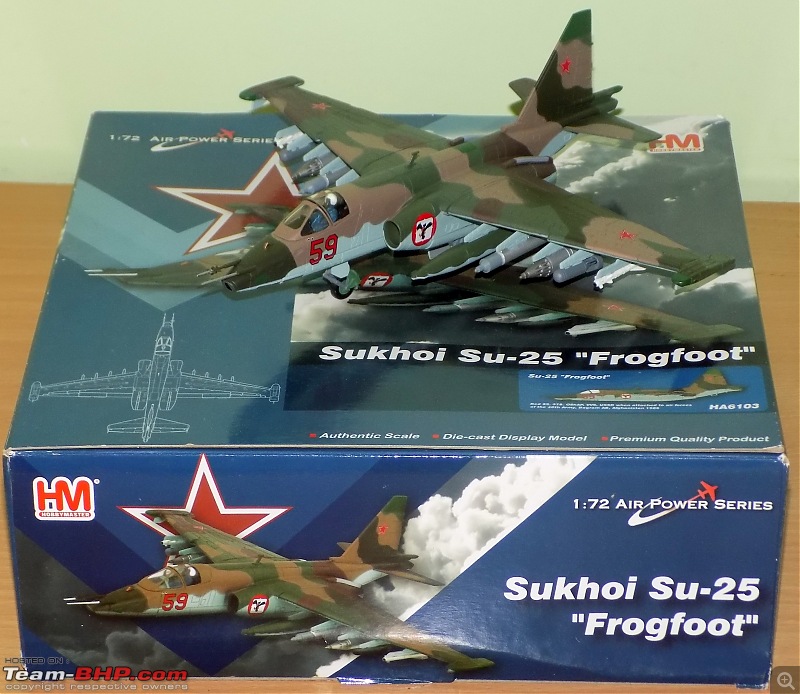      The Su-25's ability to survive aerial scraps was completely unmatched by other Soviet aircraft. That's because like the A-10, the Frogfoot has a welded titanium armored compartment—up to 25mm thick in places—that encloses the lower half of the cockpit to protect the pilot from anti-aircraft ground fire. Nte the "Grach" painted on the port engine intake and two stars painted under the cockpit   The Frogfoot's twin engines were too close together. While they could continue to work independently if one was damaged, fire from the destroyed engine would quickly deliver the same fate to the other. Although a steel firewall and a fire suppression system improved things, the Su-25 could not change the tide of the war in Afghanistan, as CIA-supplied Stinger surface-to-air missiles assisted the Afghan fighters. Even so, the aircraft unquestionably emerged as a major addition to the Soviet Air Force. In the years to come, it would be adopted by over a dozen countries and adapted to conflicts in the central Africa, eastern Europe, and the Middle East in the coming years.  ASO-2V Chaff and Flare Dispensers  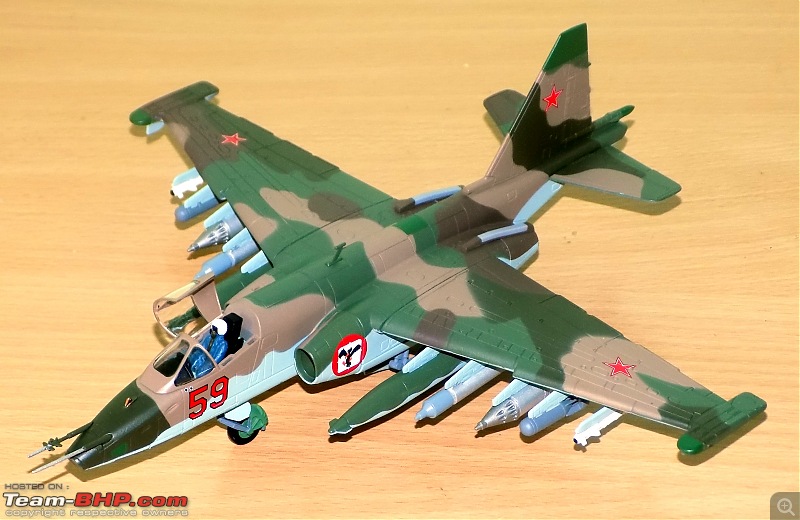   The Frogfoot's most impressive weapon iss its Gryazev-Shipunov GSh-30-2 30mm auto-cannon, capable of firing a blistering 2,500 to 3,000 rounds per minute. The cannon weighs significantly less than the A-10's own fearsome GAU-8 Avenger. The Su-25 has a nose-mounted laser rangefinder that assists with target acquisition, allowing the cannon's high explosive and depleted uranium armor-piercing shells to find their mark. For devastating strafing runs in Afghanistan, the Su-25 was sometimes fitted with wing-mounted 23mm cannon pods that wreaked havoc on the battlefield.     The post would be incomplete without the mention of a brave Russian Air Force Su-25 pilot - Major Roman Filipov. He was a Russian Su-25 pilot whose aircraft was shot down in Syria in 2018. Upon ejecting, he bravely tried to ward off those barbaric Syrian separatists with his side arm. Upon running out of ammunition, he chose to kill himself to avoid being captured after being wounded by militants as he probably knew his fate would probably be the same as that of the young Jordanian F-16 pilot who killed barbarically by ISIS by being burnt alive. Filipov was posthumously awarded the honor of the Hero of the Russian Federation.  Here is the story of Major Filipov's last stand - Quote:
Last edited by skanchan95 : 31st October 2019 at 16:16. | |
| |  ()
Thanks ()
Thanks
 |
| | #1038 |
| Distinguished - BHPian  Join Date: Aug 2014 Location: Delhi-NCR
Posts: 4,071
Thanked: 64,307 Times
| re: Scale Models - Aircraft, Battle Tanks & Ships ^^^^^^ Congratulations Sandesh. The HobbyMaster Su-25 is just so well detailed. I love its looks and you have managed some great photos. Thank you for all that useful data especially about the brave pilot. A worthy addition to your ever growing squadrons. |
| |  ()
Thanks ()
Thanks
 |
| | #1039 |
| Senior - BHPian | re: Scale Models - Aircraft, Battle Tanks & Ships
Thank you Sir. I am eagerly looking forward to seeing photos of your Hunter & Foxbat and the trivia that you so beautifully write about those aircraft. |
| |  ()
Thanks ()
Thanks
 |
| | #1040 |
| Distinguished - BHPian  | re: Scale Models - Aircraft, Battle Tanks & Ships Just a short follow up on our first F35 which arrived last week. Was supposed to get a traditional water salute. One of the fire tenders hit the wrong button and was spraying foam. https://www.thedrive.com/the-war-zon...ath-by-mistake Now it needs a very thorough inspection. This foam is highly corrosive! Not a good start. Jeroen |
| |  ()
Thanks ()
Thanks
 |
| | #1041 |
| BHPian Join Date: May 2009 Location: NYC / Lucknow
Posts: 618
Thanked: 3,536 Times
| Scale Models - Aircrafts & Ships 1:400 British Airways 747-400 "G-BYGC" in Retro BOAC livery. Its another wonderfully detailed Gemini Jets model with moving rubber wheels.       The 1:400 747 collection.  The real plane.  The only aircraft in my collection that I am 100% confident I flew on because I bought it only for that reason  Also there is only one plane in the world with this livery and registration so there can be no confusion ! Also there is only one plane in the world with this livery and registration so there can be no confusion !Photographed by me just before boarding at Heathrow, London.  Over Lower Manhattan, descending to land at JFK, New York.  British Airways launched four heritage liveries in 2019 to celebrate their 100 years and show off their pride and history.  Last edited by Foxbat : 17th November 2019 at 18:13. |
| |  ()
Thanks ()
Thanks
 |
| | #1042 |
| Distinguished - BHPian  | re: Scale Models - Aircraft, Battle Tanks & Ships Very nice. Of course BOAC did not fly the 747-400. They ceased operations somewhere mid 70’s I believe and the 747-400 came about late 80’sI think, or there Abouts. Or have I got my dates muddled up? So theirs must have been classic 747-100 or 200? Always like the BOAC livery. Very smart! Jeroen |
| |  ()
Thanks ()
Thanks
 |
| | #1043 | |
| BHPian Join Date: May 2009 Location: NYC / Lucknow
Posts: 618
Thanked: 3,536 Times
| re: Scale Models - Aircraft, Battle Tanks & Ships Quote:
 | |
| |  ()
Thanks ()
Thanks
 |
| | #1044 |
| Distinguished - BHPian  Join Date: Aug 2014 Location: Delhi-NCR
Posts: 4,071
Thanked: 64,307 Times
| re: Scale Models - Aircraft, Battle Tanks & Ships Very smart addition to your fleet. The BOAC livery was in my opinion one of the three best of the 1960s and early 1970s . The other two being Lufthansa and KLM. Congratulations Foxbat. |
| |  ()
Thanks ()
Thanks
 |
| | #1045 |
| Senior - BHPian | re: Scale Models - Aircraft, Battle Tanks & Ships 1:72 Boeing AH-64D Longbow Apache 01-5282, 8th Battalion, 229th Aviation Regiment, US Army "Flying Tigers" , Fort Knox, KY, 2005 (Hobby Master) The Boeing AH-64 Apache is an American twin-turboshaft attack helicopter with a tailwheel-type landing gear arrangement and a tandem cockpit for a crew of two. It features a nose-mounted sensor suite for target acquisition and night vision systems(Target Acquisition Designation Sight/Pilot Night Vision Sensor TADS/PNVS). It is armed with a 30 mm (1.18 in) M230 chain gun carried between the main landing gear, under the aircraft's forward fuselage, and four hardpoints mounted on stub-wing pylons for carrying armament and stores, typically a mixture of AGM-114 Hellfire missiles and Hydra 70 rocket pods. The AH-64 has significant systems redundancy to improve combat survivability. The Apache began as the Model 77 developed by Hughes Helicopters for the United States Army's Advanced Attack Helicopter program to replace the AH-1 Cobra. The prototype YAH-64 was first flown on 30 September 1975. The U.S. Army selected the YAH-64 over the Bell YAH-63 in 1976, and later approved full production in 1982. After purchasing Hughes Helicopters in 1984, McDonnell Douglas continued AH-64 production and development. The helicopter was introduced to U.S. Army service in April 1986. The advanced AH-64D Apache Longbow was delivered to the Army in March 1997. Production has been continued by Boeing Defense, Space & Security, with over 2,000 AH-64s being produced by 2013. The U.S. Army is the primary operator of the AH-64. It has also become the primary attack helicopter of multiple nations, including Greece, Japan, Israel, the Netherlands, Singapore, and the United Arab Emirates. It has been built under license in the United Kingdom as the AgustaWestland Apache. American AH-64s have served in conflicts in Panama, the Persian Gulf, Kosovo, Afghanistan, and Iraq. Israel used the Apache in its military conflicts in Lebanon and the Gaza Strip. British and Dutch Apaches have seen deployments in wars in Afghanistan and Iraq. In August 1990, development of the D variant of the AH-64 , nicknamed Longbow( for it mast mounted AN/APG-78 Longbow Fire Control radar) was approved by the Defense Acquisition Board. The first AH-64D prototype flew on 15 April 1992. Prototype testing ended in April 1995. During testing, six AH-64D helicopters were pitted against a bigger group of AH-64As. The results demonstrated the AH-64D to have a sevenfold increase in survivability and fourfold increase in lethality compared to the AH-64A. On 13 October 1995, full-scale production was approved; a $1.9-billion five-year contract was signed in August 1996 to upgrade 232 AH-64As into AH-64Ds. On 17 March 1997, the first production AH-64D flew. It was delivered on 31 March. AN/APG-78 Longbow Fire Control radar The FCR’s primary combat targeting modes include Ground Target Mode (GTM), Air Targeting Mode (ATM), and a new Maritime Targeting Mode (MTM) for the AH-64E. These modes provide rapid detection to engagement timelines. The FCR performs wide area search, precise detection, location and classification of up to 256 simultaneous moving and stationary targets. From these, the system then prioritizes the top 16 targets for immediate evaluation and, if desired, engagement by the aircrew. LONGBOW enables the potent Apache attack helicopter to prosecute targets day or night, in adverse weather and obscured conditions. Additional modes include Terrain Profile Mode, which significantly aids aircrew situational awareness to avoid terrain and large obstacles under degraded environments, including weather and battlefield conditions; and Target Location Cueing to the Apache’s Modernized Target Acquisition Designation System (MTADS) for positive target identification. The Indian Air Force recently received first of its AH-64E Apaches and inducted them into the No.125 Sqdn "Gladiators"(formerly flew the Mi-25/35 Hind). SOme of the IAF Apaches have Longbow radar. The pilot sits in the rear cockpit while the gunner/weapons operator sits in the front cockpit. Apache AH-64D Specifications and Characteristics Manufacturer/s Hughes Helicopters - 1975/1984 McDonnell Douglas – 1984/1997 Boeing Defense, Space & Security – 1997/Present Role – Attack Helicopter Crew – 2 X (Pilot + Co-Pilot/Gunner) Dimensions Fuselage Length – 49 ft 5 in (15.06 m) Length/Both Rotors Turning – 58.17 ft (17.73 m) Width – 17 ft (5.23 m) Height AH-64D NR (Non Radar) - 12.7 ft (3.87 m) AH-64D Longbow - 16.2 ft (4.95 m) Rotor Diameter – 48 ft (14.63 m) Performance Power-Plants 2 X General Electric T700-GE-701C Producing 1,890 shp Per Engine Speed Maximum – 182 mph (158 kts / 293 km/h) Cruise – 165 mph (143 kts / 265 km/h) Range Ferry – 1,180 mi (1,024 nmi / 1,900 km) Combat Radius – 300 mi (260 nmi / 480 km) Minimum Load Service Ceiling – 21,000 ft (6,400 m) Rate Of Climb – 2,500 ft/min (12.7 m/s) Armament Guns – 1 X 30 mm (1.18 in) M230 Chain Gun W/1,200 Rounds (As Part Of Area Weapon Subsystem) Hard Points – 4 X Pylons On Stub Wings Rockets Hydra 70 mm CRV7 70 mm APKWS 70 mm Air-To-Ground Missiles 8 X AGM-114 Hellfire 4 X AIM-92 Stinger Spike Missiles 8th Btn, 229th Aviation Regiment, US Army The 8th Battalion, 229th Aviation Regiment was activated in the Army Reserve on September 17, 1989 at Fort Knox, Kentucky and was granted permission by the AVG(AMerican Volunteer Group of the WW2 Flying Tigers fame) for the 8th-229th to use their logo and name so they became the Flying Tigers. The 8th Battalion first received the Apache helicopter in 1992 and in October 2005 began training for the AH-64D Longbow and became the 8th Battalion, 229th Aviation Regiment. In the fall of 2014 8th-229th exchanged their AH-64Ds for the UH-60 Blackhawk and became an assault helicopter battalion.    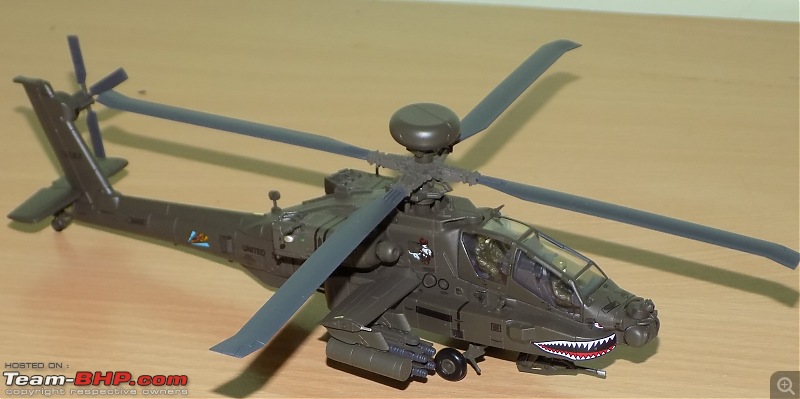   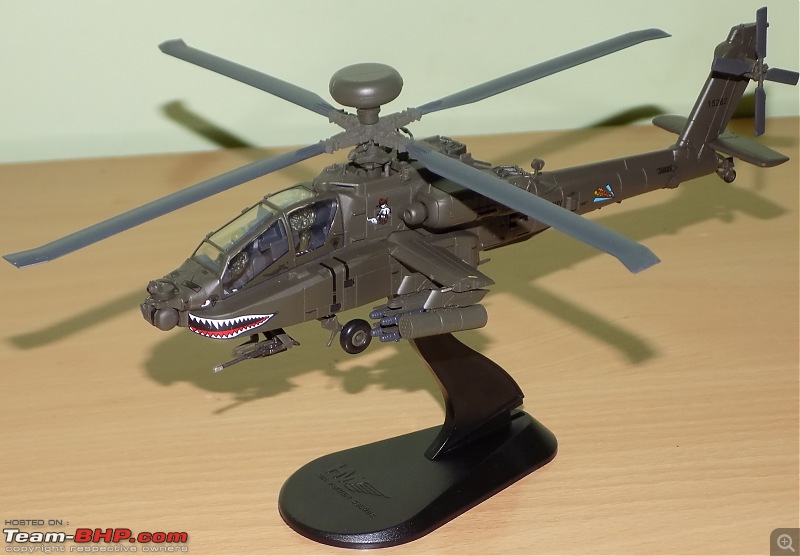   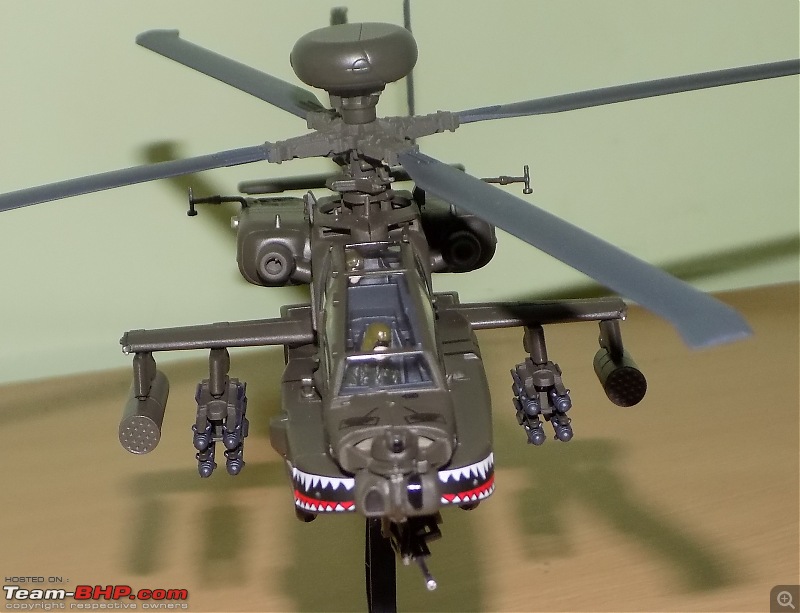  Cockpit MFDs, control stick, control panels are modelled 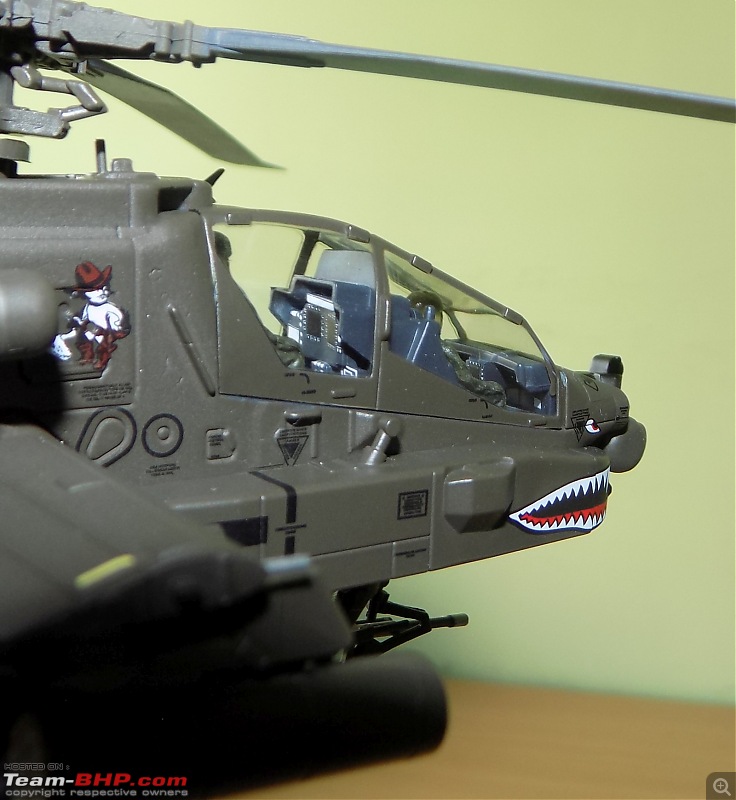 The feared tank killer      Alongside my New Ray AH-64A. Needless to say the HM Apache is miles ahead of New Ray.   The real AH-64D 01-5282  The AH-64D is one of the flyable helicopters in the old sim Enemy Engaged. Had tons of fun flying the AH-64 in that sim. Last edited by skanchan95 : 19th November 2019 at 16:35. |
| |  ()
Thanks ()
Thanks
 |
| | #1046 |
| Senior - BHPian | re: Scale Models - Aircraft, Battle Tanks & Ships 1:72 Northrop Grumman E-2C Hawkeye 164496, VAW-126 "Seahawks", USS Harry S. Truman, May 2011(Hobby Master) The Northrop Grumman E-2 Hawkeye is an American all-weather, carrier-capable tactical airborne early warning & Control (AEW&C) aircraft. This twin-turboprop aircraft was designed and developed during the late 1950s and early 1960s by the Grumman Aircraft Company for the United States Navy as a replacement for the earlier, piston-engined E-1 Tracer, which was rapidly becoming obsolete. The aircraft's performance has been upgraded with the E-2B, and E-2C versions, where most of the changes were made to the radar and radio communications due to advances in electronic integrated circuits and other electronics. The E-2 was the first aircraft designed specifically for its AEW&C role, as opposed to a modification of an existing airframe, such as the Boeing E-3 Sentry. Variants of the Hawkeye have been in continuous production since 1960, giving it the longest production run of any carrier-based aircraft. The E-2 also received the nickname "Super Fudd" because it replaced the E-1 Tracer "Willy Fudd". In recent decades, the E-2 has been commonly referred to as the "Hummer" because of the distinctive sounds of its turboprop engines, quite unlike that of turbojet and turbofan jet engines. In addition to U.S. Navy service, smaller numbers of E-2s have been sold to the armed forces of Egypt, France, Israel, Japan, Mexico, Singapore, and Taiwan. Operating from an altitude more than 25,000ft, the Hawkeye alerts the naval task force to approaching air threats, while also providing threat identification and positional data to fighter aircraft such as F-14 Tomcats and F/A-18 Hornets. Secondary roles include strike command and control, surveillance, guidance of search and rescue missions and as a relay to extend the range of communication. Since May 2004, US Navy Hawkeye 2000 aircraft have been fitted with two Hamilton Sundstrand NP2000 eight-bladed, digitally controlled propellers( like the one on this scale model) to replace mechanically controlled, four-bladed propellers. The new propellers result in reduced vibration and make less noise. Initial carrier certification of the new propellers was carried out on USS John F Kennedy in November 2003. Mission systems of E-2C The large, 24ft diameter, circular antenna radome above the rear fuselage gives the E-2C its distinctive profile. The radome houses the AN/APA-171 antenna supplied by Randtron Systems, which rotates at 5rpm to 6rpm. The Lockheed Martin AN/APS-145 radar can track more than 2,000 targets and control the interception of 40 hostile targets. One radar sweep covers six million cubic miles. The radar’s total radiation aperture control antenna reduces side lobes and is robust against electronic countermeasures. It is capable of detecting aircraft at ranges greater than 550km. The Lockheed Martin AN/UYQ-70 advanced display system and computer peripherals provide operators with multicolour displays, map overlays, zoom facilities and auxiliary data displays. In August 2005, Northrop Grumman completed the E-2C mission computer replacement programme with the provision of faster, more powerful and additionally reliable computers. T56-A-425 turboprop engines The E-2C was originally fitted with two Allison T56-A-425 turboprop engines, but since the introduction of E-2C Group I variants, T56A-427 engines with 3,800kW of output power have been fitted. With the new engines, the E-2C can cruise on station for more than four hours, up to 200 miles away from its base. Specifications for the Northrop E-2C Hawkeye Crew – 5 : 1 Pilot, 1 Co-Pilot, 1 Radar Officer (RO), 1 Combat Information Center Officer (CICO), 1 Aircraft Control Officer (ACO) Dimensions Length – 57 ft 8.75 in (17.60 m) Wingspan – 80 ft 7 in (24.56 m) Height – 18 ft 3.75 in (5.58 m) Weight Empty – 40,200 lb (18,090 kg) Loaded – 43,068 lb (19,536 kg) Maximum Take-off – 57,500 lb (26,083 kg) Performance Engines – 2 x Allison / Rolls Royce T56-A-427 5,100 shp (3,800 kW) each Speed Maximum – 350 knots (648 km/h) Cruise – 256 knots (474 km/h Ferry Range – 1,462 nmi (2,708 km) Service Ceiling – 34,700 ft (10,576 m) Endurance – 6 hrs Avionics AN/APS-145 Radar OL-483/AP IFF interrogator system APX-100 IFF Transponder OL-698/ASQ Tactical Computer Group AN/ARC-182 UHF/VHF radio AN/ARC-158 UHF radio AN/ARQ-34 HF radio AN/USC-42 Mini-DAMA SATCOM system VAW-126 "SeaHawks" VAW-126 Seahawks were established in 1969 with a home base at Naval Air Station Norfolk, Virginia equipped with the E-2A Hawkeye. Over time their equipment has been upgraded to the E- 2B, E-2C, E-2C Hawkeye 2000 (HE2K) and the E-2C+ Group II. E-2C 164496 MSN A-159 received an 8-blade propeller. Previous to flying with VAW-126 E-2C 164496 flew with VAW-120, VAW-124 and VAW-121. The aircraft carrier USS Harry S. Truman made its maiden voyage with VAW-126 assigned to it and they have been together ever since. Apart from the cockpit crew, the three radar and mission controllers sit in a very confined space inside the cabin. I found this to be a interesting read: Confessions Of An E-2C Hawkeye Radar Operator   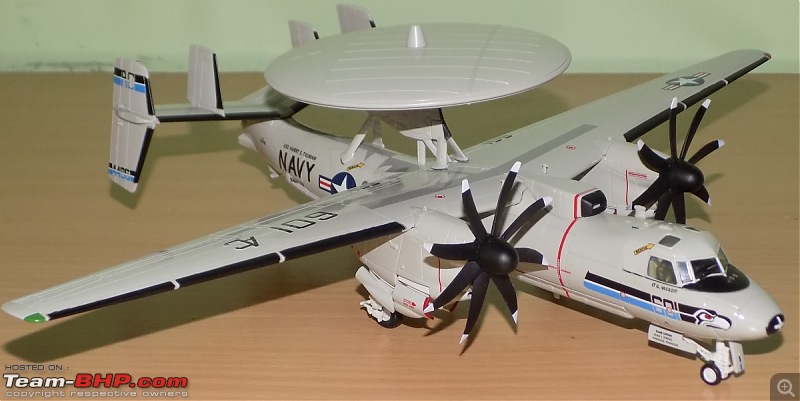 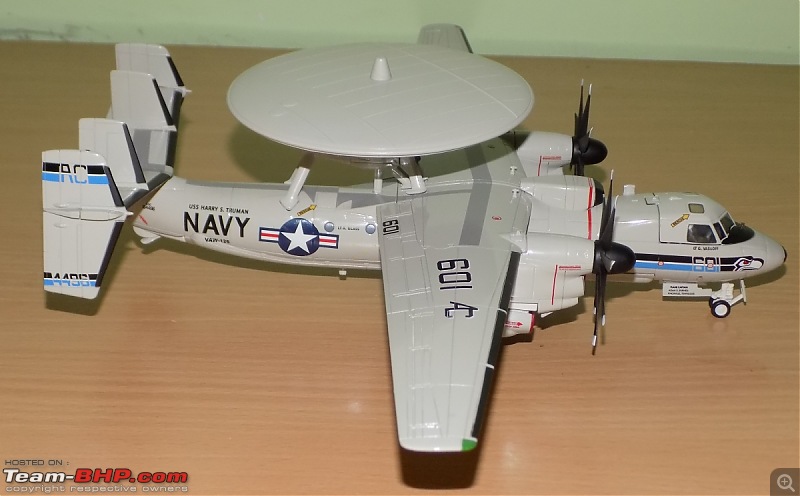   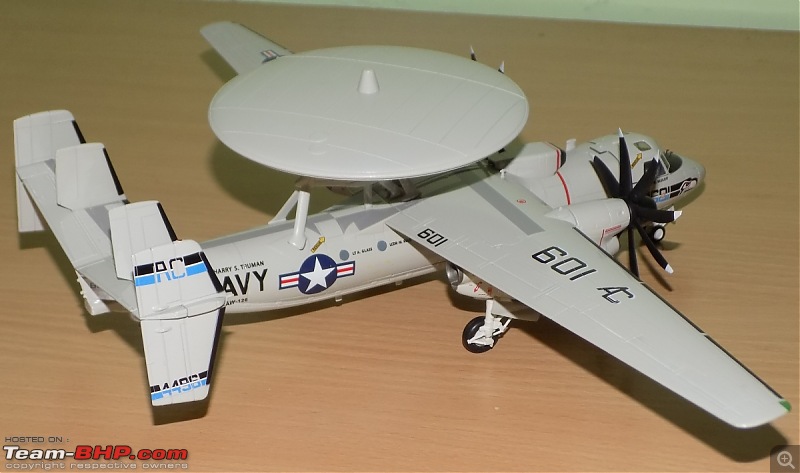 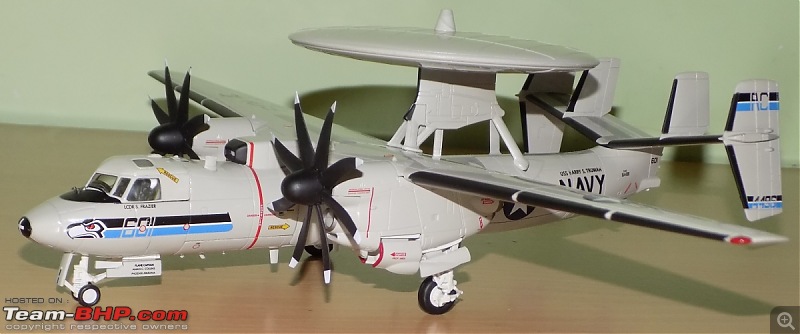  Names of the Pilots -Lt. G Vasiloff & Lt Cdr S Frazier  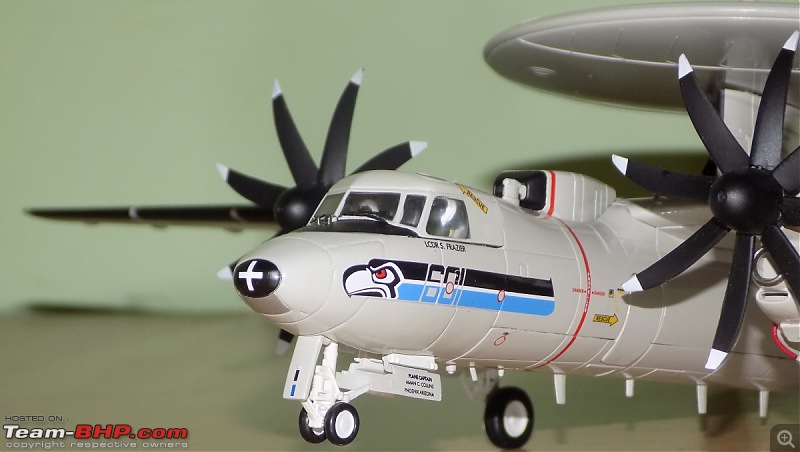 Names of the Radar & Mission Control officers - Lt A Glass & Lt Cdr M Rule. The radar dome, can be rotated.   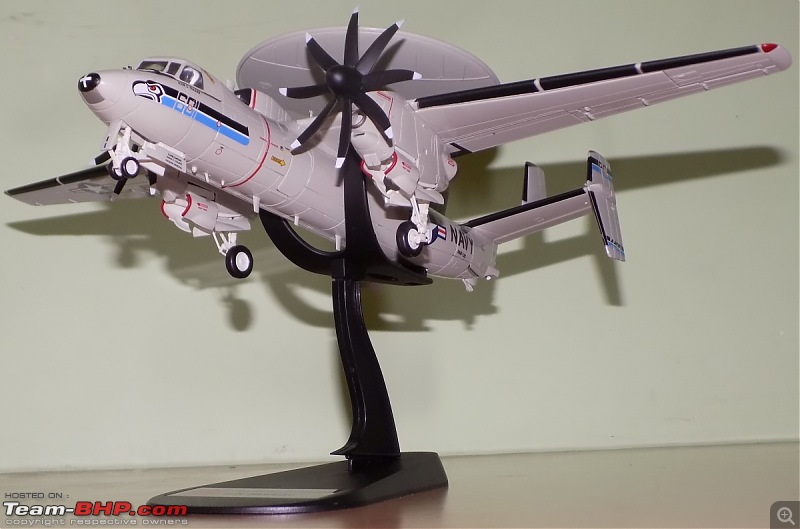   The cockpit detailing: 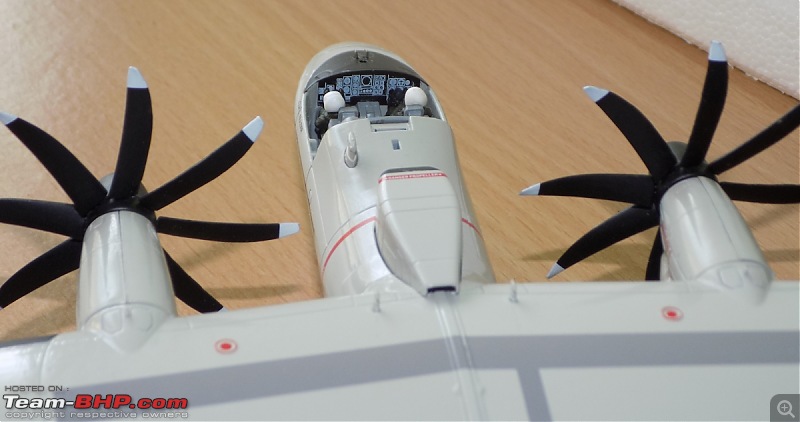  E-2 Wings folded for storage/parking on the aircraft carrier:  The real E-2C 164496 with VAW-126 markings of this model  The C-2 Greyhound, designed to carry supplies, mail, and passengers to and from aircraft carriers of the United States Navy. Its primary mission is carrier onboard delivery (COD) is a derivative of the E-2 Hawkeye, shares wings and power plants with the E-2, but has a widened fuselage with a rear loading ramp. VAW-126 Hawkeye was directly involved in the 1989 Gulf of Sidra Incident, where two F-14As of VF-32 "Swordsmen" shot down two Libyan MiG-23s. The video and transcript gives a fair idea about the co-ordination between an E-2, fighter interceptors it guides and the C&C on the aircraft carrier: The second Gulf of Sidra incident occurred on 4 January 1989 when two United States Navy F-14 Tomcats shot down two Libyan MiG-23 Floggers that appeared to have been attempting to engage them, as had happened eight years prior in the first Gulf of Sidra incident, in 1981.On the morning of 4 January 1989, the Kennedy battle group was operating some 130 km north of Libya, with a group of A-6 Intruders on exercise south of Crete, escorted by two pairs of F-14As from VF-14 and VF-32, and as well as an E-2C from VAW-126. Later that morning the southernmost Combat Air Patrol station was taken by two F-14s from VF-32, (CDR Joseph Bernard Connelly/CDR Leo F. Enwright in BuNo 159610, ‘AC207’) and (LT Hermon C. Cook III/LCDR Steven Patrick Collins in BuNo 159437, ‘AC202’). The officers had been specially briefed for this mission due to the high tensions regarding the carrier group’s presence; the pilots were advised to expect some kind of hostilities. The on station E-2C Hawkeye of VAW-126 (callsign CLOSEOUT) detected two streamed pairs of Libyan fighters launching from the base at Al Bumbah, with GYPSY 207 subsequently leading the intercept as Enright identified on his own radar at a bearing of 175 degrees, range 72 nautical miles, flying at 10,000 feet. As the Libyan fighters were soon confirmed on the Tomcats’ TCS screens as being fully armed Libyan MiG-23 FLOGGERs – continued the F-14s went through a series of manoeuvres to offset the MiGs, which would then re-position a number of times. Before the final phases of the engagement, the US Navy pilots used their long range radars and locked onto the Libyan MiG-23s. In past brushes with the Libyans, they would usually retire to the south, taking the warning at face value. This time, however, despite repeated radar lock-ups, the Libyans bored straight in. The radio transcript reveals the stress of the situation:- Gypsy 207 RIO Collins: “Gypsy 207 contact at 175, 72 miles, looks like a flight of two, Angels 10.” CLOSEOUT: “Closeout concurs, showing 78 miles.” Gypsy 204 RIO Enright: “Throttle back just a little bit here.” (The Radar Intercept Officer is asking the pilot to slow so as to provide more time for him to lock on and for the Libyans to respond.) CLOSEOUT: “Closeout shows 25 mile separation for an inbound” Gypsy 207 RIO Collins: “Contacts appear to be heading, ah, 315 now, speed 430, Angels approximately 8,000.” CLOSEOUT: “Roger Ace, take it north.” Gypsy 204 Pilot Cook: “Looks like we’ll have to make a quick loop here.” Gypsy 204 RIO Enright: “Come starboard, ah I need to give ya collision here. Yeah, come starboard about 40.” Gypsy 207 RIO Collins: “207 ah, 61 miles now, bearing 180, Angels 8, heading, uh, 330.” Gypsy 204 RIO Enright: “Steady up.” CLOSEOUT: “Alpha Bravo this is Closeout.” Gypsy 204 RIO Enright: “Come back port, ah, 20 degrees here, he’s jinkin’ now.” Gypsy 207 RIO Collins: “Bogies appear to be coming, ah, jinking to the right now, heading, uh, north, speed 430, ah, Angels 5,000 now in the descent. So lets take her down now, we’re goin’ down.” CLOSEOUT: “Concur.” At this point in the conflict, the aircraft are still far apart, but closely rapidly. The F-14A Tomcats elect to descend so as to ensure that their radar gets a clear lock-on without ground clutter that might foul-up the radar picture of the engagement. Gypsy 207 RIO Collins: “Closeout, 53 miles now. Bogies appear to be heading directly at us. I’m coming towards…. Steady up 150 for 33 offset, 50 miles. 49 miles now, speed 450, Angels 9, I’m goin’ down to 3.” Gypsy 204 Pilot Cook: “Yes, they did not go over.” Gypsy 207 Pilot Connelly: “Roger.” Gypsy 207 RIO Collins: “Roger that, 30 degree offset now. Bogies heading 340, speed 500, lets accelerate.” Gypsy 207 Pilot Connelly: “Okay, it looks like they are at 9,000 feet now.” Gypsy 207 RIO Collins: “Roger, bogies are jinked back into us now, now let’s come starboard 30 degrees the other side.” Gypsy 204 Pilot Cook: “Coming starboard, say your Angels.” Gypsy 207 RIO Collins: “Roger, Angels now 11, ready up.” CVG-67 Kennedy Shipboard Air Command (Alpha Bravo): “Closeout ah, Warning yellow, weapons hold, I repeat, warning yellow, weapons hold. Alpha Bravo out.” CLOSEOUT: “Roger, Gypsies, pass up, Alpha Bravo directs warning yellow, weapons hold.” Gypsy 207 Pilot Connelly: “35 miles here.” Gypsy 207 RIO Collins: “Roger that. Bogies have jinked back into me now for the third time. Nose is on at 35 miles, Angels 7.” CLOSEOUT: “Alpha Bravo, Closeout, did you copy?” At this point, the US Navy pilots have repeatedly attempted to turn and manoeuvre so as to position themselves favorably against the incoming threat. Each time, however, the Libyan pilots receive GCI (Ground Control Intercept) guidance to adjust course so as to ensure that the F-14s do not gain any advantage. With each turn (or “jink” in the parlance of US Navy fighter pilots), the Libyans cancel out the American manoeuvre and press in, ensuring a head-on engagement, which is their best (if slim) hope of effectively engaging the Americans. Gypsy 207 RIO Collins: “Okay, I am taking another offset, starboard, starboard, ah, 210.” CLOSEOUT: “Guys, I’m locked up here 30 miles, Angels 13,000, he’s the trailer.” Gypsy 207 RIO Collins: “Roger that, level off here, bogie jinked back into me for the 4th time. I’m coming back starboard. I’m back port now. Port 27 miles, bogie is at 7,000 feet.” Gypsy 207 Pilot Connelly: “We’re at 5.” CVG-67 Kennedy Shipboard Air Command (Alpha Bravo): “Watch out, bogies 135-50, Angels 16, heading 340.” (This call is for the second pair of Libyan MiGs, but it is misinterpreted by Closeout to mean the pair being engaged and the threat is not passed on.) Gypsy 207 Pilot Connelly: “Okay.” CLOSEOUT: “Roger, same bogies.” Gypsy 207 Pilot Connelly: “Okay, you’re in collision now, steering.” Gypsy 207 RIO Collins: “Okay, bogies have jinked back at me again for the fifth time. They’re on my nose now. Inside of 20 miles.” The Libyans have now closed to within a reasonable range. For the US Navy pilots, this means that they have to engage and shoot down the planes. The Libyans are positioned nearly 11,000 feet higher than the American planes, which elected to go low to improve their radar performance, as earlier described. The Libyan planes, however, have vastly inferior radar systems and probably could not get a good radar picture of the threat they were facing. They went by GCI guidance alone — at no time is the Radar Warning Receiver (RWR) heard in the audio files from the F-14s, thus the Libyans never locked out for a firing solution. The Americans proceed to engage with the intent to destroy the two Libyan planes. Gypsy 207 RIO Collins: “Master arm on, master arm on.” (Sound of Master Arm Alert in background.) CLOSEOUT: “Okay, good light” Gypsy 207 Pilot Connelly: “Good Light” Gypsy 207 RIO Collins: “Okay, centering up the T, bogie has jinked back into me again, 16 miles, at the center of the dot.” CLOSEOUT: “Say your Angels.” Gypsy 207 RIO Collins: “I’m at Angels 5, nose up.” CLOSEOUT: “No, his Angels.” Gypsy 207 Pilot Connelly: “No, wait a minute.” Gypsy 207 RIO Collins: “Angels are at 9!” Gypsy 207 Pilot Connelly: “Alpha Bravo from 207.” Gypsy 207 RIO Collins: “13 miles. Fox 1! Fox 1!” Gypsy 207 Pilot Connelly: “Ah, Jesus!” The pilot of Gypsy 207, Joseph B. Connelly, is surprised to see one of his missiles launch, as the attack wasn’t properly coordinated by his RIO, Steven P. Collins. Seconds later, the AIM-7M Sparrow missile fails to track properly. RIO Collins had improperly set a switch on the missile prior to launch, which resulted in its failure (this was a recurring problem with AIM-7M Sparrow missile launches from F-14A Tomcats at the time. Gypsy 204 Pilot Cook: “Breaking right.” Gypsy 207 RIO Collins: “Roger that, 10 miles, he’s back on my nose. Fox 1 again!” (This time, he has the switch set correctly and the missile tracks true — it takes time, however, to reach the target.) Gypsy 207 Pilot Connelly: “Watching ‘em up.” Gypsy 207 RIO Collins: “6 miles, 6 miles.” Gypsy 204 RIO Enright: “Tally 2, Tally 2! Turning into me.” The RIO in Gypsy 204, Leo F. Enright, spotted the two Libyan MiG-23s as they were now just six miles dead ahead. The Libyans were closing quickly and had negated the F-14′s long range systems advantage, despite all. At this point, the engagement threatened to devolve into an old-school gunfighter-style dogfight. The Libyans had played their cards well and the US Navy’s lead plane, Gypsy 207, had made two critical firing mistakes with its AIM-7M Sparrow radar-guided missiles. Gypsy 207 RIO Collins: “Roger that, 5 miles. . . 4 miles.” Gypsy 207 Pilot Connelly: “Okay, he’s got a missile off.” Gypsy 204 RIO Enright: “Breakin’ right.” Gypsy 207 Pilot Connelly: “Good hit, good hit on one!” (The second AIM-7M Sparrow missile fired hits the MiG-23 and scores a kill.) Gypsy 207 RIO Collins: “Roger that, good kill, good kill!” Gypsy 204 Pilot Cook: “I’ve got the other one.” Gypsy 204 RIO Enright: “Select fox 2, select fox 2!!” Gypsy 204 Pilot Cook: “I got fox 2.” (Cook refers to the selection knob being already turned to select the heat-seeking AIM-9M Sidewinder missiles.) CLOSEOUT: “Keep your eye for the trailer.” Gypsy 207 RIO Collins: “Comin’ hard starboard.” Gypsy 204 Pilot Cook: “Those fxxxkin’!” Gypsy 204 RIO Enright: “Shoot him!” Gypsy 204 Pilot Cook: “I don’t got tone.” Gypsy 207 RIO Collins: “That’s the second one.” Gypsy 204 Pilot Cook: “I’ve got the second one on my nose right now.” Gypsy 207 RIO Collins: “Okay, I am high cover on you.” Gypsy 204 Pilot Cook: “Get a fox, get a, lock him up! Lock him up.” Gypsy 204 RIO Enright: “There! Shoot him, fox 2!” Gypsy 204 Pilot Cook: “I can’t! I don’t have a fxxxking tone.” (The calmness and matter-of-fact tone of the pilot, almost academic in phrase even if swearing, is interesting; he seems to be working the problem and is momentarily angry that his system doesn’t seem to be working like it should — yet he is taking the time to work the issues while he trails the MiG in firing position.) t this point, Gypsy 204′s pilot, Hermon C. “Munster” Cook III, has the Libyan MiG-23 lined up perfectly in his HUD. Everything is right on and he is within 1.5 miles of the MiG, directly behind it. Incredibly, the pilots hears no missile tone from the AIM-9M Sidewinder missile. Moments later, Cook realizes that he simply has the volume turned down to the stops. Turning up the knob, he is greeted by the perfect growling tone of the missile, which is tracking the target perfectly. As for the Libyans, they seem unable to keep up with the rapidly changing air combat. Gypsy 204 did an early break and then reversed to come in behind the Libyan MiG, pulling a continuous 5Gs in the maneuver. Once too close for radar-based weapons-systems, Gypsy 204′s pilot selected heat-seeking missiles, which are fired from up front and the RIO, Leo F. Enright, transitioned to a different role in the fight, keeping his eyes open and tracking the overall combat picture and planning for the egress afterward, thus freeing up the pilot to concentrate on the attack. The Libyan MiG pilot, who should have pulled out sharply into a tightly turning dogfight, is tentative and does not maneuver effectively. It would appear that while the GCI instructions had been perfect and had countered the F-14s in their earlier positioning, now that the combat is engaged, the Libyans lack the individual pilot initiative to fight “head-to-head” in a turning fight. Gypsy 204 Pilot Cook: “Tone’s up!” (Once volume knob is twisted, the tone growls instantly to high volume.) Gypsy 204 RIO Enright: “Fox 2.” (The RIO calls the pilot’s launch of an AIM-9M Sidewinder heat-seeking missile.) Gypsy 204 Pilot Cook: “Good kill! Good kill!” Gypsy 207 RIO Collins: “Okay, good kill.” Gypsy 207 RIO Collins: “Pilot ejected.” CLOSEOUT: “The pilot’s ejected out of the second one.” (The E-2C Hawkeye is relaying the radio report to the USS Kennedy’s Air Command (Alpha Bravo). For a few brief seconds, the two F-14s track the two parachutes of the Libyans as they descended toward the water. They also watch for the impact of the two MiG-23s into the water. Then they turn and descend, accelerating away and to the north. As earlier briefed, the Libyans had another two MiG-23s airborne, even if they were 50 km further south, and this was a threat that was on the minds of the pilots and RIOs. Though they would have likely been able to engage and shoot down those as well, they didn’t know where the other aircraft were. Their assumption was that the other two MiGs were far enough away or had turned off the track since the early warning radar aircraft, the E-2C Hawkeye “Closeout” did not provide reporting during the engagement. In fact, “Closeout” called the two other aircraft earlier but the call was misinterpreted by the two Tomcat crews. Gypsy 204 RIO Enright: “Okay Munster, lets head north, head north.” Gypsy 207 RIO Collins: “Okay. Port side high, comin’ down hard.” Gypsy 204 RIO Enright: “Roger.” Gypsy 207 RIO Collins: “Roger that. Just revert. Blowin’ north, let’s go down low on the decks, unload, 500 knots, lets get out of here.” Gypsy 204 Pilot Cook: “Okay, two good chutes.” CLOSEOUT: “They’re showin’ two good chutes in the air here, from Munster.” Gypsy 207 RIO Collins: “Roger that, I see the, ah–.” Gypsy 207 Pilot Connelly: “I’ve got the splash, one splash.” Gypsy 207 RIO Collins: “One splash.” Gypsy 204 RIO Enright: “Take that down to, ah, 3,000 here Munster.” CLOSEOUT: “The, ah, splash 160 at 96.” Gypsy 204 RIO Enright: “Lets go, Munster down to 3,000 and lets get outta here.” Last edited by skanchan95 : 20th November 2019 at 12:44. |
| |  ()
Thanks ()
Thanks
 |
| |
| | #1047 |
| Senior - BHPian | re: Scale Models - Aircraft, Battle Tanks & Ships 1:200 Airbus A320-231 Indian Airlines VT-EYL (Inflight 200) Narayan Sir posted the same model earlier in this thread and it is a fabulous A320 model. Short lived livery after Indian Airlines got re-branded as "Indian" and eventually merged with Air India. Airframe details Serial number : 480 Type : A320-231 First flight date : 24/05/1994 Test registration : F-WWDU Plane age : 25.5 years Engines : 2 x IAE V2500-A1 Airline : Indian Airlines/Air India Country : India Date Delivered : 20/05/2006 Returned to Lessor : 07/2011 *Currently flying as EP-APG with Iran Aseman Airlines 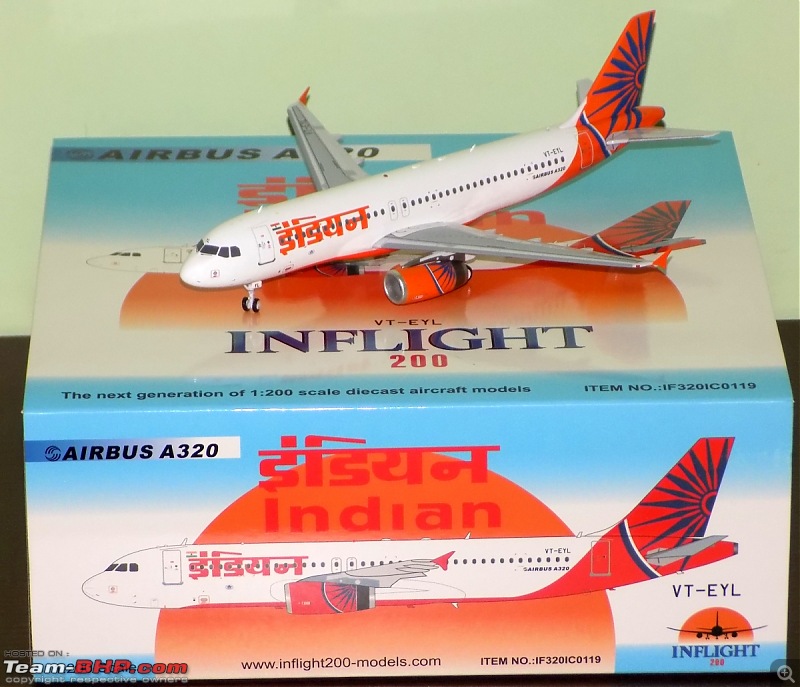   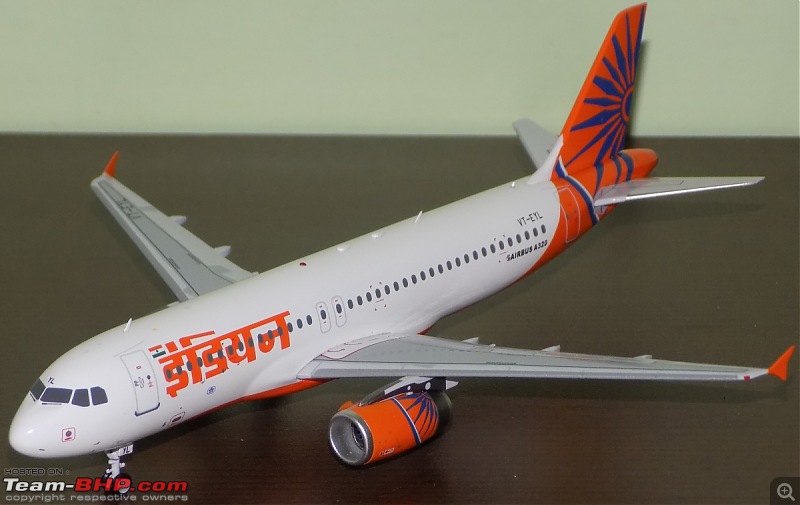   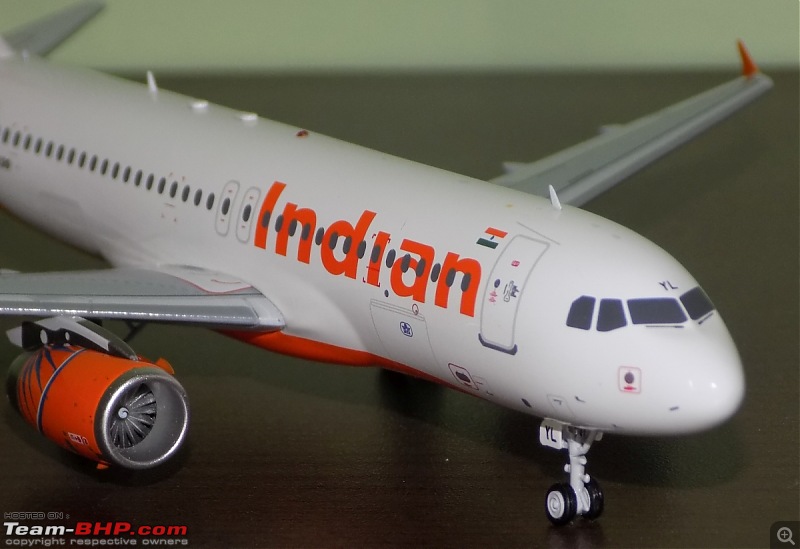 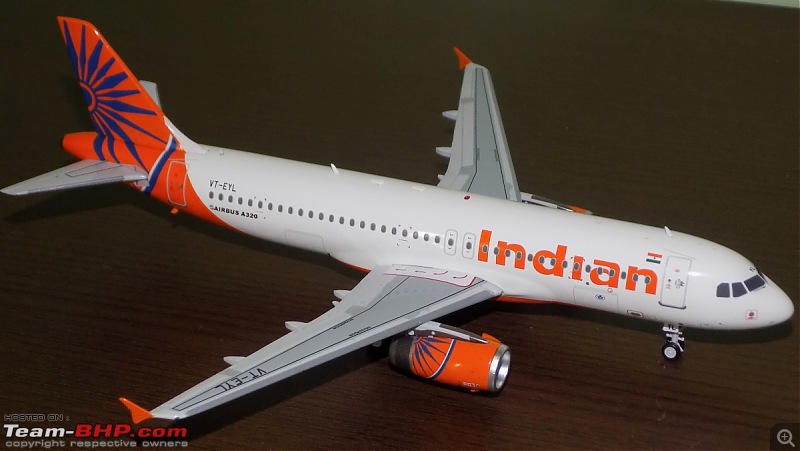    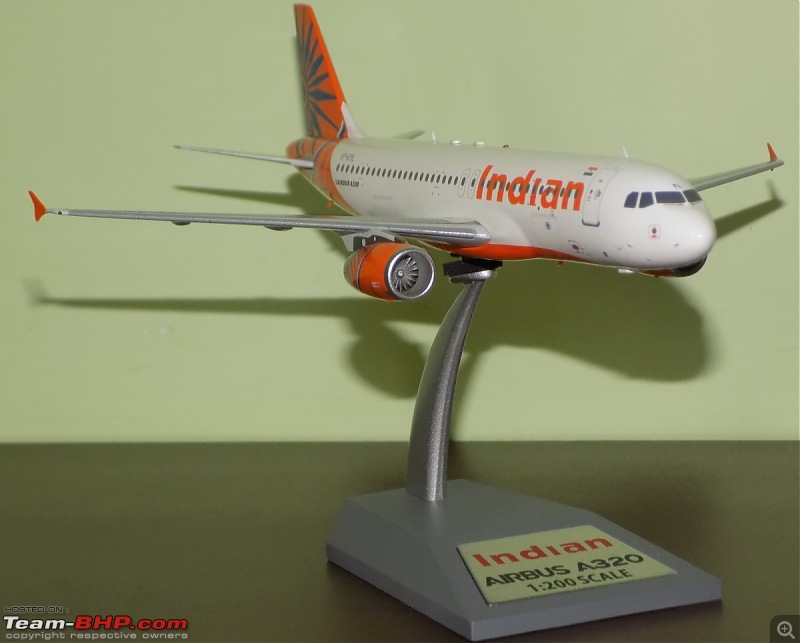 My Indian Airlines A320 fleet:  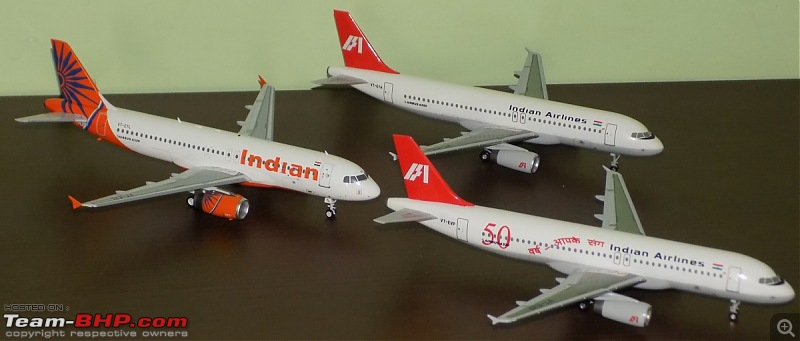    The real VT-EYL:  Currently flying as EP-APG  This is a question that has been in my head ever since I started notching different engine types on the same aircraft type (IAE /CFM/PW Engines on the A320, RR/PW/GE engines on the B757 etc). What factors do airlines decide which engine is to be fitted on their aircraft fleet, say an A320 fleet with Go Air or Indigo or Air India? All three airlines have both IAE & CFM powered A320 Classics. Why not have a single engine type for ease of maintenance? Does one engine brand offer better performance/ FE over the other? How come DGCA is allowing Indigo and Go Air to place more orders for A320neo with its troublesome PW1127G engine instead of asking them to switch over to CFM LEAP-1 engines which have had a nearly trouble free record with Air India & VIstara's A320neo fleet? Last edited by skanchan95 : 21st November 2019 at 11:38. |
| |  ()
Thanks ()
Thanks
 |
| | #1048 |
| Distinguished - BHPian  Join Date: Aug 2014 Location: Delhi-NCR
Posts: 4,071
Thanked: 64,307 Times
| re: Scale Models - Aircraft, Battle Tanks & Ships ^^^^^^^^^^^^^ skanchan95, Boy are you on a roll! That Apache is without doubt the number one most beautifully detailed aircraft scale model I have seen in a while. Simply delightful in detail, realism and looks. And then you go and top it off with the Hawkeye (and beat me to it Grrrrrr!). Hobby Master has become so good with its quality that it isn't funny. I wish they break into civilian transports too. all three acquisitions are proud additions to your fleet. Congratulations.  |
| |  ()
Thanks ()
Thanks
 |
| | #1049 | |
| Senior - BHPian | re: Scale Models - Aircraft, Battle Tanks & Ships Quote:
I picked this particular Hawkeye primarily because of a Hawkeye from VAW-126 was directly involved in the 2nd Gulf of Sidra incident and secondly because the eight blade propellor Hawkeye looks better than a four blade one. However, it was the T-55 that I was most impressed with. The intricate and crisp details, especially of the Tank tracks, left me amazed. Tanks and APCs are something I always wished it have in my collection and the HM T-55 is an amazing model to kick it off with. | |
| |  ()
Thanks ()
Thanks
 |
| | #1050 |
| Senior - BHPian | re: Scale Models - Aircraft, Battle Tanks & Ships I just had to do a photoshoot of the 1:72 HM Hawkeye & Tomcat together  . .    I had the impression that the Hawkeye was bigger than the Tomcat. But in reality and as evident in this pic, the Tomcat was slightly bigger. 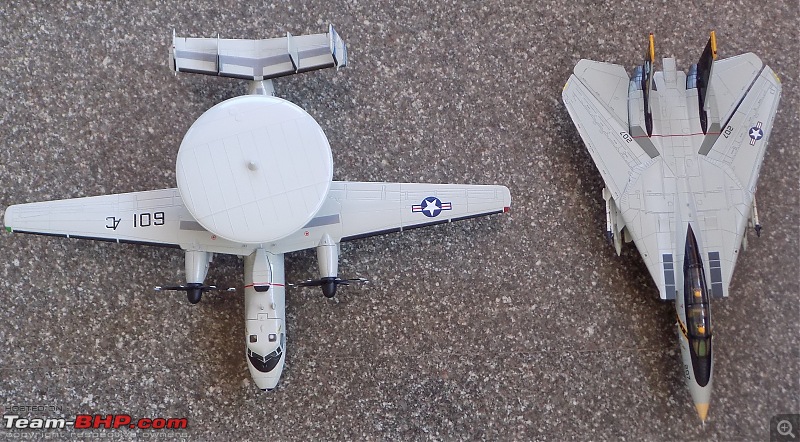   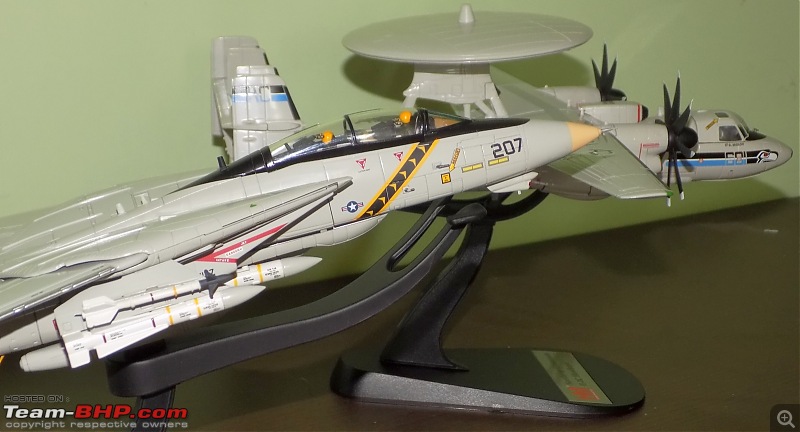  |
| |  ()
Thanks ()
Thanks
 |
 |


